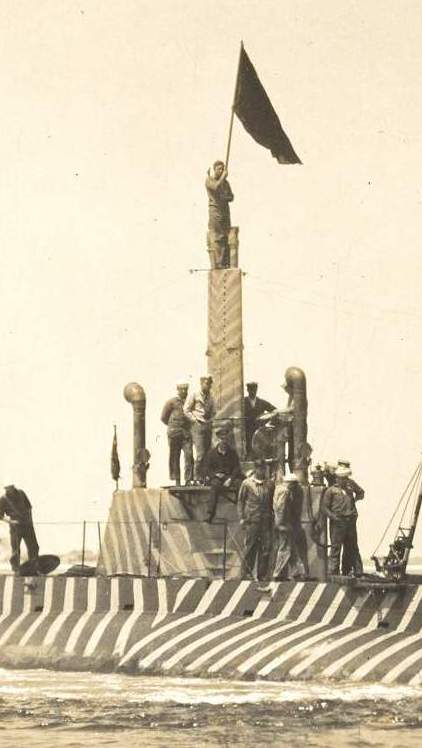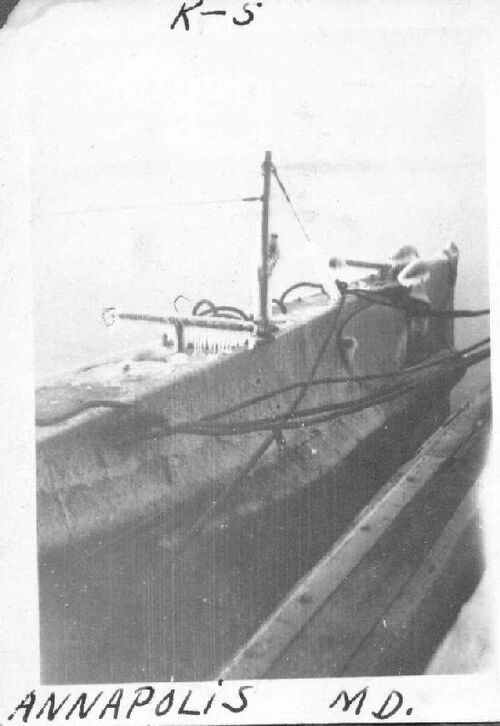K-5

Photo in the private collection of Ric Hedman.

A fine quality photo of the K-5's crew loading a torpedo, fall of 1914. The location is not known for sure, but it is likely the Boston Navy Yard, as K-5 was initially stationed there until November 1914.
The weapon is a Bliss-Leavitt Mk 7 and it is being gingerly lowered onto the raised torpedo loading skid on the boat's forward deck. The angled loading hatch is open, and there are containers of grease under the skid, used to facilitate the slide of the weapon down the skid and into the room. A snubbing line has been attached around the tail fins. On the far right of the photo, just visible at the edge, is a short ventilation pipe on the forward edge of the conning tower fairwater. This pipe will be used like a bollard, with several turns of the snubbing line belayed around it, helping the sailors control the descent of the weapon down the skid.
Note the extremely small rudders on the torpedo, and the twin contra-rotating propellers needed to stop the torpedo from rolling along its axis as it moved. Also visible between the blades is a propeller lock mechanism, a safety device used to prevent accidental hot runs of the engine. It would be removed prior to loading the weapon in the tube.
In the safety conscious atmosphere of the 21st century it is amazing to see two of the sailors on the loading team, the Chief and the sailor to his immediate right, smoking a cigarette while working. In the 2025 Navy the smoking lamp would be out throughout the boat and even on the entire pier.
The African American Chief Petty Officer in the middle would have been one of the last to openly serve in the role of a Gunners Mate (no Torpedomen in those days). President Wilson and his Secretary of the Navy Josephus Daniels segregated the armed forces soon after Wilson's inauguration. Afterwards, Sailors of color were restricted to the Cook and Mess Attendant rates for over 40 years.
Photo in the private collection of David Johnston.

K-5 returning to port in Norfolk, VA., December 13, 1916. The city of Hampton is in the background, with portions of Buckroe Beach visible. This location puts her very near the Thimble Shoals Light.
In February 1916 the K-5 had become "lost" in a fog off the east coast on her way to Key West, Florida. She did not respond to any of the many radio messages sent her way to find out her condition. This caused a panic and reports that she may have been lost began to surface. News of the "loss" spread through the newspapers with reports of men aboard from that town or city began springing up almost, but not quite, as obituaries. Finally, the K-5 was sighted off Miami, Florida on Feb 12, 1916. Apparently, her radio was not working correctly in the dense foggy weather causing the panic.
Photo NH 52376 courtesy of NHHC, a copy is in the private collection of Ric Hedman.

K-5 dressed in what was known as "Dazzle" camouflage, circa 1917. This paint scheme was never intended to hide the ship. In fact, it was intended to make it very difficult for an enemy submarine or surface ship to determine course, range, and speed, all extremely important elements in obtaining a fire control solution for aiming weapons at a target. The paint scheme was unique to each ship so that it was harder for an enemy to determine the ship's class. Maintaining this paint scheme was difficult, and no definitive proof could be obtained that showed that it was actually effective. None of the USN submarines deployed to the European war zone carried this paint scheme. The tests on submarines ended prior to their deployments. The well-known haze gray paint scheme became the standard until the mid 1930's.
Photo courtesy of Dave Snyder.

On September 12, 1919 while returning to Key West from operations in Caribbean waters, K-5 collided with the harbor tug USS John L. Lawrence (SP-838). Damage to both vessels was actually quite light, but K-5 was hauled out on the marine railway in Key West to make sure. Other non-collision repair work was conducted as well. Four crew are posing around the bow. The K-5 shows the improvements made to her with her WW I service such as the Fessenden Oscillator seen as the large disk, seen just above the right shoulder of the man at the bottom. Also seen on deck are the SC and K-tube sound listening gear for detecting ships and submarines, an early form of sonar. Also, as almost all submarines from WW I, she has the metal bridge enclosure giving protection to the crew at sea.
Photo courtesy of the Monroe County Library Collection.

Starboard side view of the K-5 hauled out on the marine railway at Key West, Florida, September, 1919.
Photo courtesy of the Monroe County Library Collection.

The K-5's radio set, early 1920's. On the K-class the radio room was in the forward battery compartment in the aft port corner.
Photo in the private collection of Ric Hedman.

Electrical and battery control panels in the K-5's after battery compartment, aft port corner. From here the Electrician's Mates controlled the flow of electricity to and from the boat's batteries, and control the speed of the boat while submerged.
Photo in the private collection of Ric Hedman.

K-5's galley and stove, just forward of the electrical panels seen above.
Photo in the private collection of Ric Hedman.

The K-5's after battery compartment, looking at the aft starboard corner. A grinding wheel and bench vice can be seen in this photo. A compressed gas bottle is strapped to the bulkhead.
Photo in the private collection of Ric Hedman.

An unfortunately overexposed photo of K-5's engine room and motor room, looking aft. The engines are NELSECO 240V8FS diesels.
Photo in the private collection of Ric Hedman.

This view is of K-5's motor room and engine room looking forward. The door leads into the after battery room. Her main motors were made by an Electric Boat subsidiary called Electro Dynamic and are on either side of this photo.
Photo in the private collection of Ric Hedman.

A photo of the K-5 crew on the aft deck while at sea, early 1920's. The open hatch leads into the engine room.
Photo in the private collection of Ric Hedman.

In this era all torpedoes doubled as both warshots and exercise practice rounds. You simply changed the warhead. The exercise head was filled with water to simulate the weight of the explosive warhead. After firing an exercise weapon, the firing submarine was responsible for retrieving the weapon so that it could be reused. This photo shows K-5 after retrieving a Bliss-Leavitt 18" Mk 7 torpedo in the early 1920's. The torpedo loading derrick was used to pull the weapon from the water and hoist it on deck. Once lowered below to the torpedo room, the weapon would be overhauled and put back into service.
Photo in the private collection of Ric Hedman.

Two of the K-5's Chief Petty Officers lounging on the forward deck while in port, early 1920's. One man has his dress uniform on and is likely waiting to go on liberty. The other is likely in the duty section and will remain onboard until the next day. Enlisted sailors in the USN have a saying: The officers are in charge, but the Chiefs run the Navy. That was true in the 1920's and it is still true 100 years later.
Photo in the private collection of Ric Hedman.

A view of K-5's starboard bow coated in ice while on a port visit to the United States Naval Academy at Annapolis, MD. in the early 1920's. The T-shaped bar is the array for the SC-tube sonar. It was rotatable and could give a reasonably accurate bearing to the target.
Photo in the private collection of Ric Hedman.

Another view of K-5's bow encrusted in ice on a cold and damp day in Annapolis. MD. in the early 1920's.
Photo in the private collection of Ric Hedman.

LTjg K.J. McLaughlin (center), the K-5's Chief Engineer and likely also the Executive Officer, poses with the boat's engineering department crew on the engine room hatch while the boat was underway in a stiff breeze. Location unknown but likely the early 1920's
Photo courtesy of MMCM(SS) Rick Larson, USN (Ret.).
Page created by:
Ric Hedman & David Johnston
1999 - 2023 - PigBoats.COM©
Mountlake Terrace, WA, Norfolk, VA
webmaster at pigboats dot com
